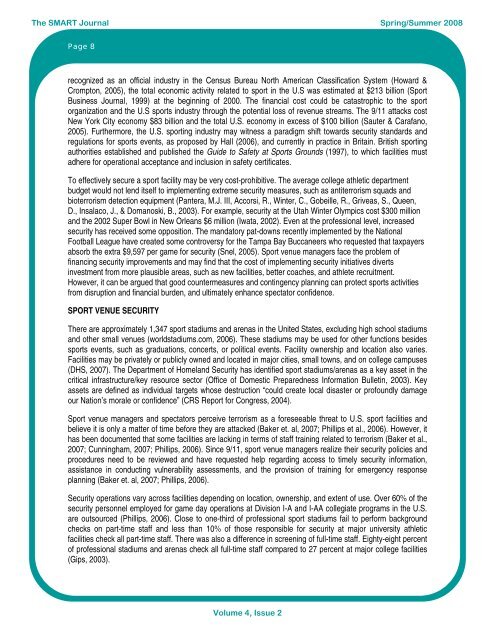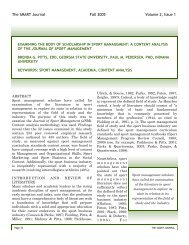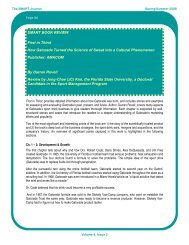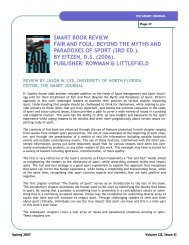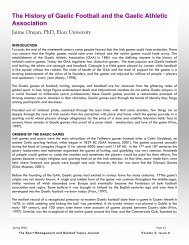Spring/Summer 2008 Volume 4, Issue 2 - The SMART Journal
Spring/Summer 2008 Volume 4, Issue 2 - The SMART Journal
Spring/Summer 2008 Volume 4, Issue 2 - The SMART Journal
Create successful ePaper yourself
Turn your PDF publications into a flip-book with our unique Google optimized e-Paper software.
<strong>The</strong> <strong>SMART</strong> <strong>Journal</strong> <strong>Spring</strong>/<strong>Summer</strong> <strong>2008</strong><br />
Page 8<br />
recognized as an official industry in the Census Bureau North American Classification System (Howard &<br />
Crompton, 2005), the total economic activity related to sport in the U.S was estimated at $213 billion (Sport<br />
Business <strong>Journal</strong>, 1999) at the beginning of 2000. <strong>The</strong> financial cost could be catastrophic to the sport<br />
organization and the U.S sports industry through the potential loss of revenue streams. <strong>The</strong> 9/11 attacks cost<br />
New York City economy $83 billion and the total U.S. economy in excess of $100 billion (Sauter & Carafano,<br />
2005). Furthermore, the U.S. sporting industry may witness a paradigm shift towards security standards and<br />
regulations for sports events, as proposed by Hall (2006), and currently in practice in Britain. British sporting<br />
authorities established and published the Guide to Safety at Sports Grounds (1997), to which facilities must<br />
adhere for operational acceptance and inclusion in safety certificates.<br />
To effectively secure a sport facility may be very cost-prohibitive. <strong>The</strong> average college athletic department<br />
budget would not lend itself to implementing extreme security measures, such as antiterrorism squads and<br />
bioterrorism detection equipment (Pantera, M.J. III, Accorsi, R., Winter, C., Gobeille, R., Griveas, S., Queen,<br />
D., Insalaco, J., & Domanoski, B., 2003). For example, security at the Utah Winter Olympics cost $300 million<br />
and the 2002 Super Bowl in New Orleans $6 million (Iwata, 2002). Even at the professional level, increased<br />
security has received some opposition. <strong>The</strong> mandatory pat-downs recently implemented by the National<br />
Football League have created some controversy for the Tampa Bay Buccaneers who requested that taxpayers<br />
absorb the extra $9,597 per game for security (Snel, 2005). Sport venue managers face the problem of<br />
financing security improvements and may find that the cost of implementing security initiatives diverts<br />
investment from more plausible areas, such as new facilities, better coaches, and athlete recruitment.<br />
However, it can be argued that good countermeasures and contingency planning can protect sports activities<br />
from disruption and financial burden, and ultimately enhance spectator confidence.<br />
SPORT VENUE SECURITY<br />
<strong>The</strong>re are approximately 1,347 sport stadiums and arenas in the United States, excluding high school stadiums<br />
and other small venues (worldstadiums.com, 2006). <strong>The</strong>se stadiums may be used for other functions besides<br />
sports events, such as graduations, concerts, or political events. Facility ownership and location also varies.<br />
Facilities may be privately or publicly owned and located in major cities, small towns, and on college campuses<br />
(DHS, 2007). <strong>The</strong> Department of Homeland Security has identified sport stadiums/arenas as a key asset in the<br />
critical infrastructure/key resource sector (Office of Domestic Preparedness Information Bulletin, 2003). Key<br />
assets are defined as individual targets whose destruction “could create local disaster or profoundly damage<br />
our Nation’s morale or confidence” (CRS Report for Congress, 2004).<br />
Sport venue managers and spectators perceive terrorism as a foreseeable threat to U.S. sport facilities and<br />
believe it is only a matter of time before they are attacked (Baker et. al, 2007; Phillips et al., 2006). However, it<br />
has been documented that some facilities are lacking in terms of staff training related to terrorism (Baker et al.,<br />
2007; Cunningham, 2007; Phillips, 2006). Since 9/11, sport venue managers realize their security policies and<br />
procedures need to be reviewed and have requested help regarding access to timely security information,<br />
assistance in conducting vulnerability assessments, and the provision of training for emergency response<br />
planning (Baker et. al, 2007; Phillips, 2006).<br />
Security operations vary across facilities depending on location, ownership, and extent of use. Over 60% of the<br />
security personnel employed for game day operations at Division I-A and I-AA collegiate programs in the U.S.<br />
are outsourced (Phillips, 2006). Close to one-third of professional sport stadiums fail to perform background<br />
checks on part-time staff and less than 10% of those responsible for security at major university athletic<br />
facilities check all part-time staff. <strong>The</strong>re was also a difference in screening of full-time staff. Eighty-eight percent<br />
of professional stadiums and arenas check all full-time staff compared to 27 percent at major college facilities<br />
(Gips, 2003).<br />
<strong>Volume</strong> 4, <strong>Issue</strong> 2


